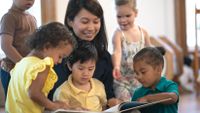How to Start Talking About Race in the Early Elementary Classroom
0 General Document comments
0 Sentence and Paragraph comments
0 Image and Video comments
Young kids are curious about what’s going on in the world right now, and teachers can help correct misinformation and provide context.

As the nation reckons with its long history of racial injustice, kids are being inundated with headlines and conversations on the topics of race and racism—and they’ve got questions, writes Kelley R. Taylor for School Library Journal.
Experts agree that while children shouldn’t be exposed to graphic or otherwise inappropriate information, parents and teachers should discuss race and racism openly and early. That’s because beginning in preschool, research shows, kids begin sorting people by race. By age 6, “children can be conscious of social stereotypes,” and “naturally attribute positive traits to their own ethnic or racial groups,” Taylor writes.


The goal, says psychologist and educator Beverly Daniel Tatum, author of Why Are All the Black Kids Sitting Together in the Cafeteria?, is “to talk in a warm and inclusive way about differences that exist in different people.” Avoiding these conversations—for fear of saying the wrong thing, or under the guise of colorblindness—is a missed opportunity. “If you can’t talk about [race], you can’t understand it, much less fix the racial problems that plague our society,” says Monnica T. Williams, a clinical psychologist.
There are several steps teachers can take to foster substantive conversations.
CURATE DIVERSE BOOKS AND CONTENT
Educators can start with the classroom bookshelf and aim to develop a collection of diverse books that teach “age-appropriate lessons on racial injustice and history, and that do not gloss over painful truths,” Taylor writes. But diverse book collections should do more than portray the oppression of people of color, says clinical psychologist Ann Hazzard, coauthor of the children’s book Something Happened in Our Town: A Child’s Story About Racial Injustice. These collections should be rich and varied and include books about “diverse individuals having typical childhood experiences,” Hazzard says.


In English, math, science, social studies, art, and music, examine the contributions of diverse cultures. Writing specifically about the contributions of Black people in these areas, former teacher Rann Miller calls this “infusing Black history into the curriculum year-round.” Black History Month, notes Miller, isn’t a “gimmick meant for one month out of the year, with a student assembly or a potluck dinner with traditional Black foods. Black history is American history. Students should learn through the year and throughout all disciplines about the accomplishments, experiences, and perspectives of Black people.”


BUILD IN ANTI-BIAS LESSONS
Teaching kids about race and racism, says Hazzard, is a process: “Addressing bias takes openness and courage…. It’s not just one conversation.” Because kids’ social and emotional development is a central piece of the elementary curriculum, it’s important to teach lessons about bias, diversity, and social justice, says Jinnie Spiegler, director of curriculum for the National Education Division of the Anti-Defamation League. “Social and emotional skill development lessons are the foundation, and then teachers can move to lessons on identity, differences, bias, and how bias and bullying can be addressed individually and institutionally,” she advises.


MODEL ACTION
What adults do—far more than what they say—can have a big impact on kids. “Adults who actively engage in cycles of learning, listening, and talking about antiracism may be more effective at teaching children to be antiracist,” Taylor writes. For teachers, this may mean joining “school and district policy reform efforts to reduce racial disparities in educational opportunities and school discipline,” says Hazzard, the psychologist. And beyond curating rich and diverse book collections and hosting book talks featuring a broad range of voices and experiences, school librarians can “advocate for local equity initiatives or support scholarship fundraisers for diverse organizations,” Taylor writes.





Having parents model good behavior shows kids where to start

Sin embargo, una mala relación entre los padres puede tener efectos negativos en la crianza de los hijos. Los conflictos constantes, la falta de comunicación y la falta de apoyo entre los padres pueden generar estrés y ansiedad en los niños. Estos pueden sentirse inseguros y confundidos, afectando su autoestima y relaciones futuras. Además, la falta de cooperación entre los padres puede llevar a decisiones contradictorias en la crianza, lo que confunde a los niños y puede generar problemas de comportamiento. En resumen, una mala relación entre los padres puede ser perjudicial para la salud emocional y el desarrollo de los hijos.

Los padres son un factor muy importante en la vida los niñ@s ya que ellos les enseñan todo, Es muy cierto que si los padres no enseñan a los niños a respetar en un futuro se vuelven rebeldes y groseros con las demas personas.Es muy importante escucharlos hablarles etc para una buena comunicación.

Y con esto su forma de comportarse puede verse muy afectada ya se de una manera positiva o negativa
Taking on the sensitive topics of race and racism in the classroom is important work that requires “self-reflection and humility,” says Janet R. Damon, library services specialist for Denver Public Schools: “We all bring fear, childhood trauma, and trepidation to these conversations.” But to better understand the damaging influences of systemic racism, privilege, and unconscious bias in education, “educators must reflect on their own (sometimes painful) race-related experiences,” writes Taylor. “The resulting awareness can make them more powerful role models for children.”


General Document Comments 0









0 archived comments